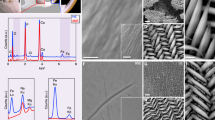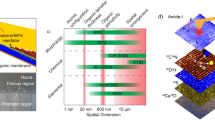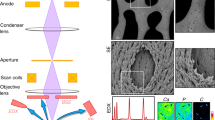Abstract
Biological organisms possess an unparalleled ability to control the structure and properties of mineralized tissues. They are able, for example, to guide the formation of smoothly curving single crystals or tough, lightweight, self-repairing skeletal elements1. In many biominerals, an organic matrix interacts with the mineral as it forms, controls its morphology and polymorph, and is occluded during mineralization2,3,4. The remarkable functional properties of the resulting composites—such as outstanding fracture toughness and wear resistance—can be attributed to buried organic–inorganic interfaces at multiple hierarchical levels5. Analysing and controlling such interfaces at the nanometre length scale is critical also in emerging organic electronic and photovoltaic hybrid materials6. However, elucidating the structural and chemical complexity of buried organic–inorganic interfaces presents a challenge to state-of-the-art imaging techniques. Here we show that pulsed-laser atom-probe tomography reveals three-dimensional chemical maps of organic fibres with a diameter of 5–10 nm in the surrounding nano-crystalline magnetite (Fe3O4) mineral in the tooth of a marine mollusc, the chiton Chaetopleura apiculata. Remarkably, most fibres co-localize with either sodium or magnesium. Furthermore, clustering of these cations in the fibre indicates a structural level of hierarchy previously undetected. Our results demonstrate that in the chiton tooth, individual organic fibres have different chemical compositions, and therefore probably different functional roles in controlling fibre formation and matrix–mineral interactions. Atom-probe tomography is able to detect this chemical/structural heterogeneity by virtue of its high three-dimensional spatial resolution and sensitivity across the periodic table. We anticipate that the quantitative analysis and visualization of nanometre-scale interfaces by laser-pulsed atom-probe tomography will contribute greatly to our understanding not only of biominerals (such as bone, dentine and enamel), but also of synthetic organic–inorganic composites.
This is a preview of subscription content, access via your institution
Access options
Subscribe to this journal
Receive 51 print issues and online access
$199.00 per year
only $3.90 per issue
Buy this article
- Purchase on Springer Link
- Instant access to full article PDF
Prices may be subject to local taxes which are calculated during checkout





Similar content being viewed by others
References
Lowenstam, H. A. & Weiner, S. On Biomineralization Oxford University Press, USA. (1989)
Meldrum, F. C. & Colfen, H. Controlling mineral morphologies and structures in biological and synthetic systems. Chem. Rev. 108, 4332–4432 (2008)
Weiner, S. Biomineralization: a structural perspective. J. Struct. Biol. 163, 229–234 (2008)
Aizenberg, J. in Nanomechanics of Materials and Structures (eds Chuang, T. J., Anderson, P. M., Wu, M. K. & Hsieh, S. ) 99–108 (Springer, 2006)
Fratzl, P. & Weinkamer, R. Nature’s hierarchical materials. Prog. Mater. Sci. 52, 1263–1334 (2007)
Koch, N. Organic electronic devices and their functional interfaces. ChemPhysChem 8, 1438–1455 (2007)
Weiner, S. & Wagner, H. D. The material bone: structure-mechanical function relations. Annu. Rev. Mater. Res. 28, 271–298 (1998)
Falini, G. & Fermani, S. Chitin mineralization. Tissue Eng. 10, 1–6 (2004)
George, A. & Veis, A. Phosphorylated proteins and control over apatite nucleation, crystal growth, and inhibition. Chem. Rev. 108, 4670–4693 (2008)
Gotliv, B. et al. Asprich: a novel aspartic acid-rich protein family from the prismatic shell matrix of the bivalve Atrina rigida . ChemBioChem 6, 304–314 (2005)
Evans, J. S. “Tuning in” to mollusk shell nacre- and prismatic-associated protein terminal sequences. Implications for biomineralization and the construction of high performance inorganic-organic composites. Chem. Rev. 108, 4455–4462 (2008)
Wang, D., Wallace, A. F., De Yoreo, J. J. & Dove, P. M. Carboxylated molecules regulate magnesium content of amorphous calcium carbonates during calcification. Proc. Natl Acad. Sci. USA 106, 21511–21516 (2009)
Tao, J. H., Zhou, D. M., Zhang, Z. S., Xu, X. R. & Tang, R. K. Magnesium-aspartate-based crystallization switch inspired from shell molt of crustacean. Proc. Natl Acad. Sci. USA 106, 22096–22101 (2009)
Omelon, S. J. & Grynpas, M. D. Relationships between polyphosphate chemistry, biochemistry and apatite biomineralization. Chem. Rev. 108, 4694–4715 (2008)
Li, H., Xin, H. L., Muller, D. A. & Estroff, L. A. Visualizing the 3D internal structure of calcite single crystals grown in agarose hydrogels. Science 326, 1244–1247 (2009)
Kelly, T. F. & Miller, M. K. Atom probe tomography. Rev. Sci. Instrum. 78, 031101 (2007)
Seidman, D. N. & Stiller, K. A renaissance in atom-probe tomography. MRS Bull. 10, 717–749 (2009)
van der Wal, P., Giesen, H. J. & Videler, J. J. Radular teeth as models for the improvement of industrial cutting devices. Mater. Sci. Eng. C 7, 129–142 (2000)
Evans, L., Macey, D. & Webb, J. Distribution and composition of matrix protein in the radula teeth of the chiton Acanthopleura hirtosa . Mar. Biol. 109, 281–286 (1991)
Kuhlman, K. R., Martens, R. L., Kelly, T. F., Evans, N. D. & Miller, M. K. Fabrication of specimens of metamorphic magnetite crystals for field ion microscopy and atom probe microanalysis. Ultramicroscopy 89, 169–176 (2001)
Larson, D. J. et al. Analysis of bulk dielectrics with atom probe tomography. Microsc. Microanal. 14, 1254–1255 (2008)
Chen, Y., Ohkubo, T., Kodzuka, M., Morita, K. & Hono, K. Laser-assisted atom probe analysis of zirconia/spinel nanocomposite ceramics. Scr. Mater. 61, 693–696 (2009)
Marin, F., Luquet, G., Marie, B. & Medakovic, D. Molluscan shell proteins: primary structure, origin, and evolution. Curr. Top. Dev. Biol. 80, 209–276 (2008)
Law, N., Caudle, M. & Pecoraro, V. Manganese redox enzymes and model systems: properties, structures, and reactivity. Adv. Inorg. Chem. 46, 305–440 (1998)
Evans, L. A., Macey, D. J. & Webb, J. Characterization and structural organization of the organic matrix of the radula teeth of the chiton Acanthopleura hirtosa . Phil. Trans. R. Soc. Lond. B 329, 87–96 (1990)
Lehn, J. Supramolecular chemistry. J. Chem. Sci. 106, 915–922 (1994)
Hellman, O., Vandenbroucke, J., Rüsing, J., Isheim, D. & Seidman, D. Analysis of three-dimensional atom-probe data by the proximity histogram. Microsc. Microanal. 6, 437–444 (2002)
Addadi, L., Joester, D., Nudelman, F. & Weiner, S. Mollusk shell formation: a source of new concepts for understanding biomineralization processes. Chemistry 12, 980–987 (2006)
Fantner, G. et al. Sacrificial bonds and hidden length dissipate energy as mineralized fibrils separate during bone fracture. Nature Mater. 4, 612–616 (2005)
Bas, P., Bostel, A., Deconihout, B. & Blavette, D. A general protocol for the reconstruction of 3D atom probe data. Appl. Surf. Sci. 87, 298–304 (1995)
Tsai, G. J., Su, W. H., Chen, H. C. & Pan, C. L. Antimicrobial activity of shrimp chitin and chitosan from different treatments and applications of fish preservation. Fish. Sci. 68, 170–177 (2002)
Li, J., Revol, J. F. & Marchessault, R. H. Effect of degree of deacetylation of chitin on the properties of chitin crystallites. J. Appl. Polym. Sci. 65, 373–380 (1997)
Sikorski, P., Hori, R. & Wada, M. Revisit of chitin crystal structure using high resolution X-ray diffraction data. Biomacromolecules 10, 1100–1105 (2009)
Giannuzzi, L. A. & Stevie, F. A. A review of focused ion beam milling techniques for TEM specimen preparation. Micron 30, 197–204 (1999)
Miller, M. K., Russell, K. F. & Thompson, G. B. Strategies for fabricating atom probe specimens with a dual beam FIB. Ultramicroscopy 102, 287–298 (2005)
Thompson, K. F. et al. In situ site-specific specimen preparation for atom probe tomography. Ultramicroscopy 107, 131–139 (2007)
Miller, M. K., Russell, K. F., Thompson, K., Alvis, R. & Larson, D. J. Review of atom probe FIB-based specimen preparation methods. Microsc. Microanal. 13, 428–436 (2007)
Miller, M. K. Atom Probe Tomography: Analysis at the Atomic Level 139–153 (Plenum, 2000)
Shannon, R. Revised effective ionic radii and systematic studies of interatomic distances in halides and chalcogenides. Acta Crystallogr. A 32, 751–767 (1976)
Fleet, M. The structure of magnetite. Acta Crystallogr. B 37, 917–920 (1981)
Acknowledgements
This work was supported in part by the Canadian National Sciences and Engineering Research Council and the US National Science Foundation (DMR-0805313). FIB, SEM and (S)TEM work was performed in the Northwestern University Atomic and Nanoscale Characterization and Experimental Center (NUANCE) supported by NSF-NSEC, NSF-MRSEC, the Keck Foundation, the State of Illinois, and Northwestern University. APT measurements were performed at the Northwestern University Center for Atom Probe Tomography (NUCAPT) supported by NSF-MRI (DMR-0420532) and ONR-DURIP (N00014-0400798, N00014-0610539, N00014-0910781). We thank A. Tayi for help in preparing chitin thin film samples; B. Myers (NUANCE) for help with FIB; D. Isheim (NUCAPT), and D. Lawrence, R. Ulfig, T. Prosa and M. Greene (Cameca) for their assistance with APT; and D. Seidman for discussions.
Author information
Authors and Affiliations
Contributions
L.M.G. and D.J. designed the experiments, analysed the data and prepared the manuscript. L.M.G. performed the experiments.
Corresponding author
Ethics declarations
Competing interests
The authors declare no competing financial interests.
Supplementary information
Supplementary Information
The file contains Supplementary Figures 1-7 with legends and Supplementary Notes on Isotopic Analysis. (PDF 1002 kb)
Supplementary Movie 1
This movie shows a three-dimensional reconstruction of a region of the chiton tooth containing organic fibres that bind sodium ions (Fig. 4A). Clear co-localization of the sodium ions within the organic fibre is visible. Sodium and carbon are rendered as red and grey spheres, respectively. Oxygen and iron are rendered as light blue and pink points, respectively. For clarity, only ~5% of the Fe/O are rendered. (MPG 9706 kb)
Supplementary Movie 2
This movie shows a three-dimensional reconstruction of region of the chiton tooth where multiple fibers are bundled together. In this bundle there are fibres which bind either sodium or magnesium resulting in the co-localization of both sodium and magnesium ions around the closely bundle fibres. Similar bundles are visible in the STEM images. Sodium, magnesium and carbon are rendered as red, blue and grey spheres, respectively. Oxygen and iron are rendered as light blue and pink points, respectively. A cross-section through the fibre bundle is shown in supplementary figure 6. For clarity, only ~5% of the Fe/O are rendered. (MPG 19020 kb)
Supplementary Movie 3
This movie shows a three-dimensional reconstruction of a region of the chiton tooth containing organic fibres that bind only magnesium ions (Fig. 4D). Clear co-localization of the magnesium ions within the organic fibre is visible. Magnesium and carbon are rendered as blue and grey spheres, respectively. Oxygen and iron are rendered as light blue and pink points, respectively. For clarity, only ~5% of the Fe/O are rendered. (MPG 11118 kb)
Rights and permissions
About this article
Cite this article
Gordon, L., Joester, D. Nanoscale chemical tomography of buried organic–inorganic interfaces in the chiton tooth. Nature 469, 194–197 (2011). https://doi.org/10.1038/nature09686
Received:
Accepted:
Published:
Issue Date:
DOI: https://doi.org/10.1038/nature09686
This article is cited by
-
Directing polymorph specific calcium carbonate formation with de novo protein templates
Nature Communications (2023)
-
Ontogeny of the elemental composition and the biomechanics of radular teeth in the chiton Lepidochitona cinerea
Frontiers in Zoology (2022)
-
Elemental analyses reveal distinct mineralization patterns in radular teeth of various molluscan taxa
Scientific Reports (2022)
-
Fungal hyphae develop where titanomagnetite inclusions reach the surface of basalt grains
Scientific Reports (2022)
-
The ontogeny of elements: distinct ontogenetic patterns in the radular tooth mineralization of gastropods
The Science of Nature (2022)
Comments
By submitting a comment you agree to abide by our Terms and Community Guidelines. If you find something abusive or that does not comply with our terms or guidelines please flag it as inappropriate.



